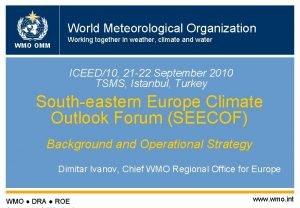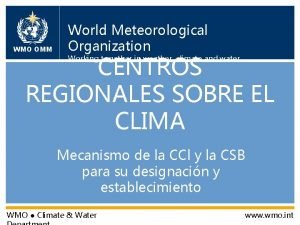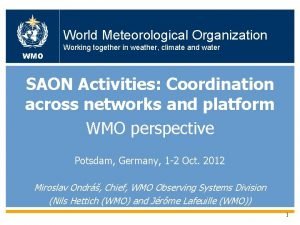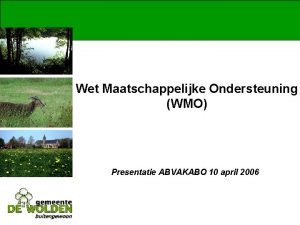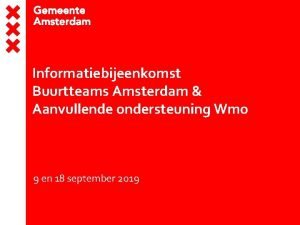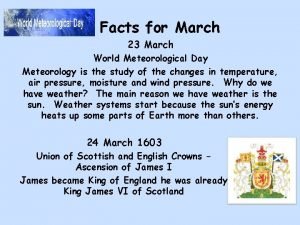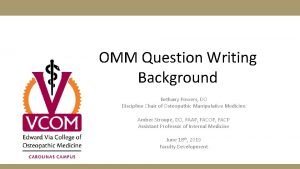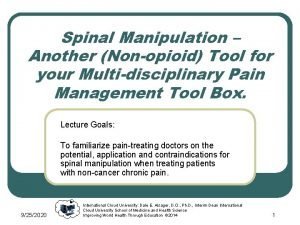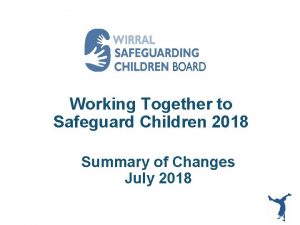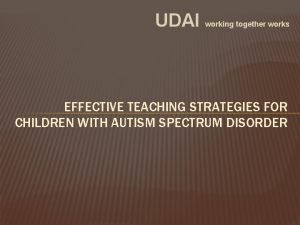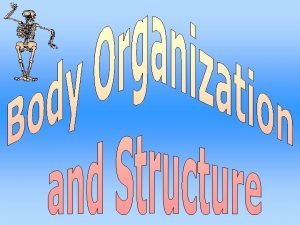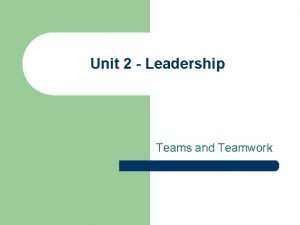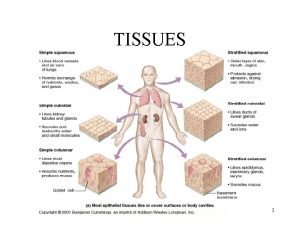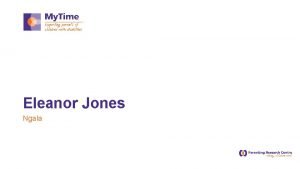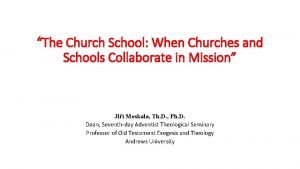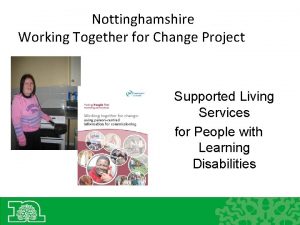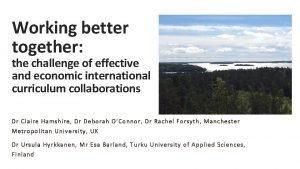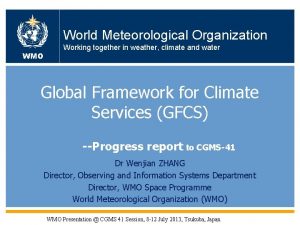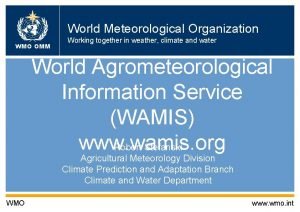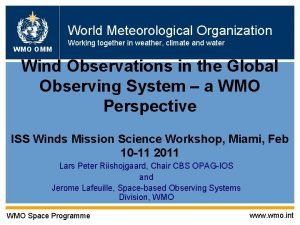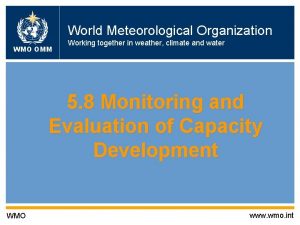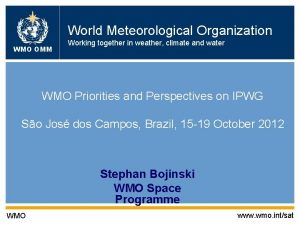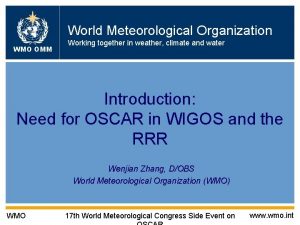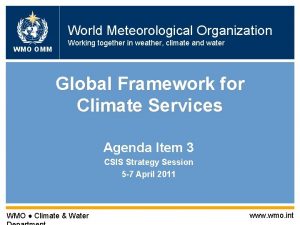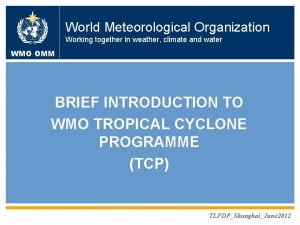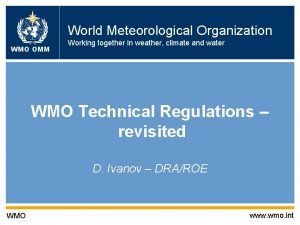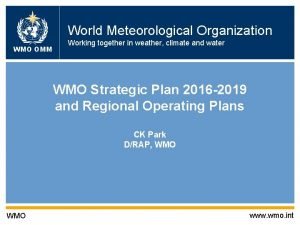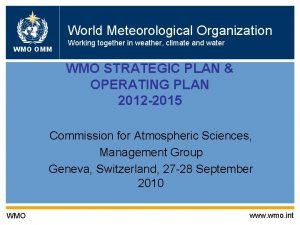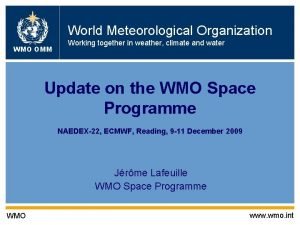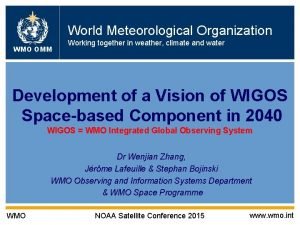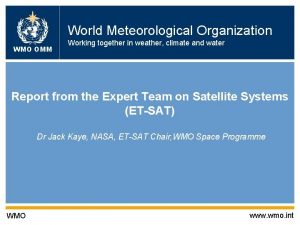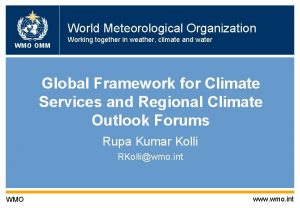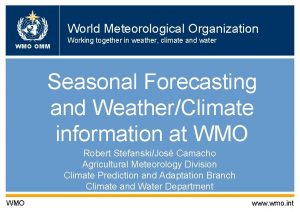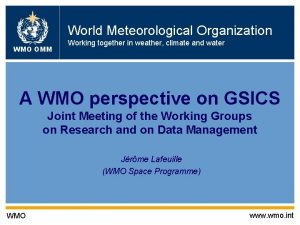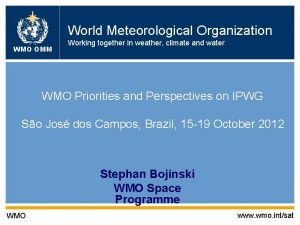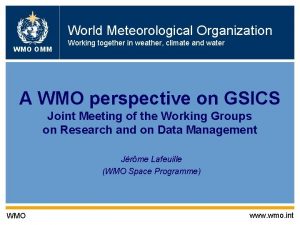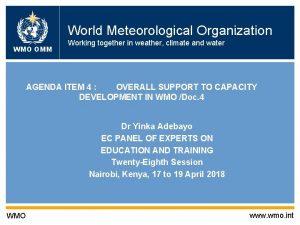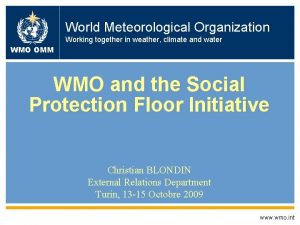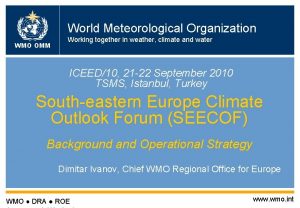World Meteorological Organization WMO OMM Working together in









































- Slides: 41

World Meteorological Organization WMO OMM Working together in weather, climate and water Concept and relevance of South Asian Climate Outlook Forum (SASCOF) R Kolli WMO www. wmo. int

World Meteorological Organization WMO OMM WMO Working together in weather, climate and water www. wmo. int

WMO OMM WCC-3 Major Sponsors 3

WMO OMM 4

WMO OMM Bridging the gap between providers and users of climate information Decision Makers User Interaction Mechanism Climate Service Providers 5

WMO OMM 6

Global Framework for Climate Services WMO OMM • Goal: – Enable better management of the risks of climate variability and change and adaptation to climate change at all levels, through development and incorporation of science-based climate information and prediction into planning, policy and practice. 7

WMO OMM GFCS: Objectives • Provide a cooperative framework in which all nations, International organizations, scientists and sectors will work together to meet the needs of users; • Enable users to benefit from improved climate information and prediction; • Mobilize climate science globally to advance the skills of seasonal-to-interannual and multi-decadal climate predictions to generate and provide future climate information on an operational basis; • Foster principles and mechanisms for sharing new advances in science and information through a cooperative global infrastructure. 8

GFCS Elements WMO OMM Climate Services Information Systems Development of information and products Research, Modelling and Prediction Delivery of Products Capacity Building Climate User Interface Programme Monitoring and Analysis Application of Products Observations 9

WMO OMM Joaquim Chissano (Mozambique) High Level Taskforce on GFCS Jan Egeland (Norway) Angus Friday (Grenada) Eugenia Kalnay (Argentina/USA) Ricardo Escobar (Chile) Co-Chair Chiaki Mukai (Japan) ) Cristina Ruiz (Spain) Rajendra Singh Paroda (India) Qin Dahe (China) Emil Salim (Indonesia) Julia Marton. Khotso Mokhele Lefèvre (South Africa) (Hungary/France/U SA) Mahmoud Abu. Zeid (Egypt)) Fiame Naomi Mata'afa (Samoa) Co-Chair 10

WMO OMM First Meeting of HLT-GFCS • Geneva, 25 -26 February 2010. • Agreed on a 3 -part structure for the report: – Part I: What climate services are available from all sources around the world that are proving to be useful – The Supply side – Part II: What is likely to be required in short, medium and long-term – The Demand side – Part III: Options for bridging gaps and implementing mechanisms to meet current and future climate services requirements with an emphasis on not duplicating what is now available - The implementation strategy • Agreed on the expected completion of the report by mid-January 2011. 11

WMO OMM Elements of Climate Services Information System 12

WMO OMM Global Producing Centres of LRF • In 2006, WMO set up a process to designate centres making global seasonal forecasts as WMO Global Producing Centres (GPCs) of Long Range Forecasts • GPCs adhere to defined standards – aiding consistency and usability of output: – a fixed forecast production cycle – a standard set of forecast products – WMO-defined verification standards (for retrospective forecasts) • A comprehensive set of standard verification measures, with which to communicate the skill of forecasts, has been defined (the WMO Standard Verification System for Long-Range Forecasts – 13

WMO OMM Currently Designated GPCs Links to GPCs: 14

WMO OMM GPC products provided as minimum requirement • Predictions for averages, accumulations, or frequencies over 1 -month periods or longer – typically, anomalies in 3 -month-averaged quantities is the standard format for seasonal forecasts. Forecasts are usually expressed probabilistically • Lead time: between 0 and 4 months • Issue frequency: monthly or at least quarterly • Delivery: graphical images on GPC website and/or digital data for download • Variables: 2 m temperature, precipitation, sea-surface temperature (SST), MSLP, 500 h. Pa height, 850 h. Pa temperature • Long-term forecast skill assessments, using measures defined by the SVSLRF 15

WMO OMM WMO Lead Centres for LRF • WMO Lead Center for Long Range Forecast Multi-Model Ensemble (LC-LRFMME) Jointly coordinated by Korea Meteorological Administration (KMA) and NOAA/NCEP http: //www. wmolc. org/ • WMO Lead Center for Standard Verification System of Long Range Forecasts (LCSVSLRF) Jointly coordinated by Bureau of Meteorology (Bo. M), Australia and Meteorological Service of Canada (MSC) 16 http: //www. bom. gov. au/wmo/lrfvs/

WMO OMM WMO El Niño and La Niña Update • The WMO El Niño/La Niña Update is a consensus statement prepared in collaboration with the International Research Institute for Climate and Society (IRI) and with contributions from NMHSs, regional and global prediction/research centres and individual experts. • Seasonal climate outlooks, as produced by NMHSs, provide detailed information on expected impacts, after considering other factors that influence regional climate. • In considering response strategies, it is important to take into account regional/national climate outlooks and not to rely solely on the presence of El Niño or La Niña. 17 • An initiative to develop a consensus-based WMO

Regional Climate Centres (RCCs) WMO OMM • WMO RCCs are Centres of Excellence performing regional-scale climate functions, designated by CBS and CCl. • Mandatory Functions: – Operational Activities for LRF – Operational Activities for Climate Monitoring – Operational Data Services, to support operational LRF and climate monitoring – Training in the use of operational RCC products and services • Highly Recommended Functions: – – – Climate prediction and projection Non-operational data services Coordination functions Training and capacity building Research and development 18

WMO OMM RCCs (contd. ) • RCCs will be complementary to and supportive of NMHSs; warnings and national-scale products will continue to be the responsibility of NMHSs • Establishment of RCCs is initiated by Regional Associations, based on regional needs and priorities, and expressed interest of potential hosts • Designation of WMO RCCs is coordinated by WMO’s Commission for Climatology (CCl) and Commission for Basic Systems (CBS), in accordance with WMO’s Technical Regulations • Implementation Status: – Beijing and Tokyo designated as WMO RCCs in June 2009. – India, Iran, Russian Federation and Saudi Arabia expressed interest to host RCCs – Pilot phase of RCC Network launched in Europe. – A Task Team is working to guide RCC implementation in Africa. – Other WMO regions also have initiated discussions on RCC 19

WMO OMM Global Network for Climate Information (WMO Designated Global and Regional Centres) ECMWF Moscow Exeter Montrea l Beijing Seoul Toulouse Tokyo Washingto n Gobal Producing Centres of Long Range Forecasts (GPCs) Regional Climate Centres (RCCs) RCC Network Nodes (Pilot) Lead Centre for LRFMME Pretoria Melbourn e Lead Centre for SVSLRF: Standardized Verification System for Long Range Forecasts LRFMME: Long Range Forecast Multi-Model Ensemble 20 CLW/CLPA/WCA S

WMO OMM WMO Network of Climate Relevant Institutions Moscow Exeter ECMWF Montreal Beijing DMCSEE Toulouse Seoul Tokyo Washington LC-LRFMME ACMAD ICPAC CIIFEN Pretoria Gobal Producing Centres of Long Range Forecasts (GPCs) SADC-DMC Melbourne Regional Climate Centres (RCCs) RCC Network Nodes (Pilot) Regional Specialized Meteorological Centres with Activity Specialization Regional Specialized Meteorological Centres with Geographical Specialization Regional climate institutions with strong WMO support LC-SVSLRF: Lead Centre for Standardized Verification System for Long Range Forecasts LC-LRFMME: Lead Centre for Long Range Forecast Multi-Model Ensemble Sand & Dust Storm Warning & Assessment System Centres Monsoon Activity Centres 21

WMO OMM Regional Climate Outlook Forums (RCOFs) • A key component of WMO Climate Information and Prediction Services (CLIPS) project activities. • First established in October 1996 at the Workshop on Reducing Climate-Related Vulnerability in Southern Africa (Victoria Falls, Zimbabwe). • Gained momentum as a regional response to the major 1997– 1998 El Niño event. • RCOF Concept was pioneered in Africa and spread worldwide. • WMO and a number of national, regional and international organizations (e. g. , NOAA, IRI, Meteo France, World Bank, etc. ) have supported their growth and expansion. 22

WMO OMM Climate Outlook Forums SASCO F 23

WMO OMM RCOF Concept (1/2) • Climate information including predictions/outlooks could be of substantial benefit to many parts of the world in adapting to and mitigating the impacts of climate variability and change. • RCOFs have the responsibility to produce and disseminate a regional assessment (using a consensus-based approach) of regional climate for the upcoming season. • Built into the RCOF process is a regional networking of the climate service providers and user-sector representatives. 24

WMO OMM RCOF Concept (2/2) • RCOFs bring together national, regional and international climate experts, on an operational basis, to produce regional climate outlooks based on input from NMHSs, regional institutions, Regional Climate Centres (RCCs) and Global Producing Centres of long range forecasts (GPCs) and other climate prediction centres. • Through interaction with sectoral users, extension agencies and policy makers, RCOFs assess the likely implications of the outlooks on the core socio-economic sectors in the region and explore potential applications of these outlooks. • RCOF sessions feed into national forums to develop detailed national-scale climate outlooks and risk information including warnings for communication to 25 decision-makers and the public.

WMO OMM RCOF Process (1/3) • Meetings of the regional and international climate experts to develop a consensus for the regional climate outlook, typically in a probabilistic form; • The Forum proper, that involves both climate scientists and representatives from the user sectors, for identification of impacts and implications, and the formulation of response strategies; • Training programmes on seasonal climate prediction to strengthen the capacity of the national and regional climate scientists; • Special outreach sessions involving sector specialists as well as media experts to develop effective communications strategies. 26

WMO OMM RCOF Process (2/3) • Determine the critical time for development of climate prediction for the region in question; • Assemble a group of experts: – Large scale prediction specialists, – regional and local climate applications and prediction/downscaling specialists, – stakeholders representative of climate-sensitive sectors; • Review current large scale (global and regional) climate anomalies and the most recent predictions for their evolution; • Review current climate conditions and their impacts at local, national and regional levels, and 27 national-scale predictions;

WMO OMM Consensus Process in RCOFs: Mostly Subjective Observations Average climate ENSO Climatology Climate patterns ENSO forecasts Assessment (conversation) Forecasts Background ENSO State Global forecasts Statistical forecasts Regional, seasonal Outlook (temp, rain, flows) Products 28

WMO OMM RCOF Process (3/3) • Considering all factors, produce a climate outlook with related output (e. g. maps of temperature and precipitation anomalies) that will be applied and fine-tuned by NMHSs in the region to meet national needs; • Discuss applications of the outlook and related climate information to climate-sensitive sectors in the region; consider practical products for development by NMHSs; • Develop strategies to effectively communicate the information to decision-makers in all affected sectors; • Critique the session and its results: – document achieved improvements to the process and any challenges encountered, – Establish steps required to further improve the process for subsequent sessions. 29

WMO OMM RCOF Success • The RCOF process has facilitated a better understanding of the links between the climate system and socioeconomic activities. • An increasing demand for climate services has been recorded in many parts of the world as a result of these developments. • Awareness has been created that climate information, including short-range climate predictions, is an essential element in mitigating against the impacts of climate variations. • RCOFs have fostered interactions and exchange of information between the climate scientists and users of climate information. 30

WMO OMM RCOFs and Food Security Outlooks • Regional agriculture and food security outlooks are now regularly produced based on the climate outlooks after the RCOFs in some regions. • For example, the climate outlook in the Greater Horn of Africa in the form of precipitation for March to May 2008 has been used by Famine Early Warning Systems Network (FEWS-NET), to prepare the Food Security Outlook for March to July 2008. 31

WMO OMM RCOFs and Public Health • Many diseases are indirectly or directly associated with climate. Vector-borne diseases are sensitive to changes in meteorological parameters such as rainfall, temperature, wind and humidity. These include malaria, dengue and Rift Valley Fever (RVF). Extreme climate events can trigger rampant outbreaks of waterborne diseases such as cholera and typhoid in areas where they are not common. • Some efforts are now being made to provide warning of changes in epidemic risk by integrating rainfall, temperature and other non-climate information. • For example, Malaria Outlook Forums (MALOFs) are now regularly held in association with RCOFs in southern Africa and the Greater Horn of Africa. • The information developed jointly by climate and health experts in these sessions, together with information on population vulnerability, food security, immuno-suppression and adequacy of control coverage, gives the health community a longer lead 32 time over which to optimize the allocation of the resources

WMO OMM RCOF for RA II (Asia): FOCRAII Precipitation Outlook, JJA 2009 Temperature Outlook, JJA 2009 33

WMO OMM PRESAO: RCOF for West Africa 34

WMO OMM SSACOF: Southeastern South America 35

WMO OMM WMO and RCOFs • WMO assists developing countries hold and benefit from these forums through CLIPS: – facilitating training workshops, – coordinating the collection and dissemination of training materials, – capacity building initiatives including some initial (limited) financial support, and – coordination of special applications to sectors (e. g. health and agriculture) • Regional institutions (e. g. , ACMAD, ICPAC, CRRH, CIIFEN, DMCs, etc. ) play key roles in the organization and overall implementation of these forums • NMHSs, the regions and the users of the products must contribute to the sustainability of COFs in the regions: demonstrate utility of the forums and value of the products to those who need the information • Research capacities at the regional level need to be enhanced, to assess the forecast skills as well as to work towards their improvement • Media has an important role to play in RCOF process, which needs to be factored in. 36

WMO OMM SASCOF Initiative (1/2) • The potential for the development of SASCOF has been discussed recently on several platforms and its importance recognized. – International symposium on Climate Change and Food Security in South Asia at Dhaka (25 -30 August 2008) called for the establishment of SASCOF. • There is a general agreement that such a process will greatly enhance regional cooperation as well as more effective engagement of the user community. • WMO’s Regional Association II (Asia), while appreciating the pan-Asia RCOF activities over the past few years led by China (FOCRAII), called for additional sub-regional RCOFs to meet the special needs of the sub-regions. • This will need active participation of all the NMHSs in the sub-region including the related multi-lateral entities. 37

WMO OMM SASCOF Initiative (2/2) • To take the first steps and scope out the implementation aspects of SASCOF, a meeting of the Directors General of the National Meteorological Services in South Asia was convened at ICTP, Trieste, Italy, on 6 August 2009. Mr Michel Jarraud, Secretary-General of WMO, addressed this meeting. • This meeting reviewed the ongoing operational activities in seasonal prediction and agreed to work towards further development of SASCOF concept. • The Permanent Representatives of countries in South Asia with WMO have unanimously agreed to establish SASCOF, to be implemented from 2010 onwards. – WMO Secretariat agreed to assist in the coordination of SASCOF sessions initially, until a permanent arrangement is worked out. – SASCOF sessions will be hosted by the participant countries by rotation. – The offer of India Meteorological Department for hosting the first three sessions, in 2010, 2011 and 2012 was unanimously accepted by the participant countries. – SASCOF will initially have exclusive focus on the summer monsoon, and the needs for covering other aspects of the sub-regional climate will be 38 addressed in due course.

WMO OMM SASCOF-1 • Following up on the SASCOF Scoping Meeting, IMD proposed to host the first session of SASCOF in Pune (this session). • WMO agreed to co-sponsor the session and provide technical support. • IITM agreed to provide logistic support and facilitate research linkages. • SASCOF-1 will consider the available predictions from global/regional centres and country-level inputs, to produce a consensus statement summarizing the available indicators of summer monsoon in 2010. • The consensus statement is expected to assist the ongoing national efforts of South Asian countries in their operational long-range forecasting activities. 39

WMO OMM Concluding Remarks • Climate-related risk management requires regional and multi-disciplinary collaborations and exchange of information, which can be achieved through interfacing institutes and processes. • It is important to find ways for all countries to cope with climate variability through improved access to climate information and prediction products. • RCOFs have fostered interactions and exchange of information between the climate scientists and users of climate information. • South Asia has a great potential to benefit from the RCOF process, with all the countries sharing a common climatic setting dominated by the monsoons. • It is proposed to take up SASCOF-2 with greater user focus, initially considering the water sector. 40

World Meteorological Organization WMO OMM Working together in weather, climate and water Thank You RKolli@wmo. int WMO www. wmo. int
 Wmo omm
Wmo omm Omm wmo
Omm wmo Wmo omm
Wmo omm Wmo omm
Wmo omm Wmo omm
Wmo omm March 23 world meteorological day
March 23 world meteorological day Viscerosomatic levels
Viscerosomatic levels Omm vs chiropractic
Omm vs chiropractic Osteopathic physical exam documentation
Osteopathic physical exam documentation Omm theme
Omm theme S jett o sang
S jett o sang Smart work and hard work
Smart work and hard work Hot working of metal is
Hot working of metal is Hot working and cold working difference
Hot working and cold working difference Differentiate between hot working and cold working
Differentiate between hot working and cold working Pembentukan logam
Pembentukan logam Working together to safeguard children 2020
Working together to safeguard children 2020 Teamwork animals working together
Teamwork animals working together Udai working together works
Udai working together works Poem on teamwork
Poem on teamwork Group of similar cells working together
Group of similar cells working together Tissues are groups of similar cells working together to
Tissues are groups of similar cells working together to Working together toward a common goal
Working together toward a common goal Circulatory and respiratory system working together
Circulatory and respiratory system working together Wtpn
Wtpn Teamwork
Teamwork Team norms
Team norms Tissues are groups of similar cells working together to
Tissues are groups of similar cells working together to Teachers and teacher aides working together
Teachers and teacher aides working together Teachers and teacher aides working together
Teachers and teacher aides working together Working together agreement
Working together agreement Working better together
Working better together Paraprofessionals and teachers working together
Paraprofessionals and teachers working together Words of wisdom about working together
Words of wisdom about working together Tissues working together
Tissues working together Churches and schools working together
Churches and schools working together Teachers and teacher aides working together
Teachers and teacher aides working together Working together for change
Working together for change Volunteers working together
Volunteers working together Working better together
Working better together Group of cells working together
Group of cells working together A group of cells similar in structure and function
A group of cells similar in structure and function
